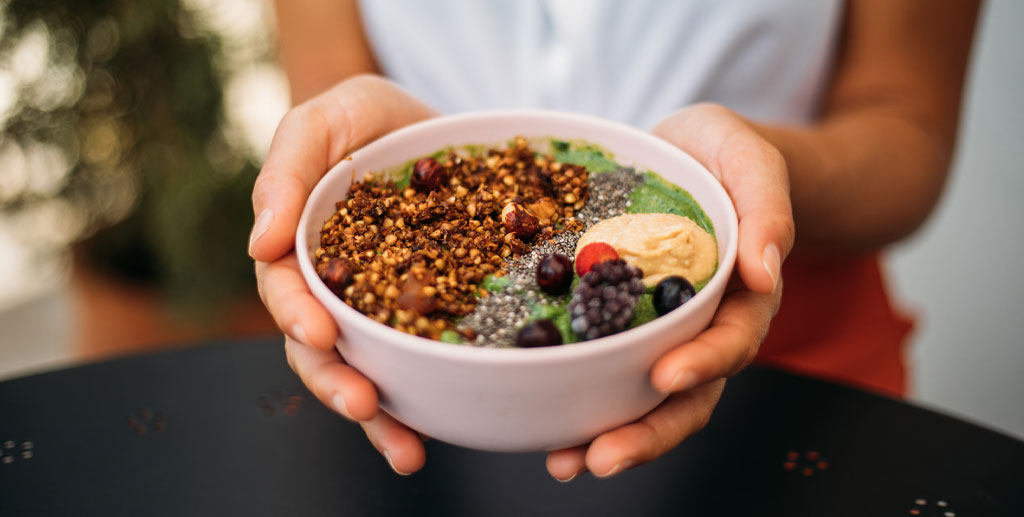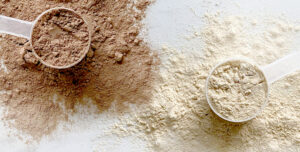A recent survey revealed that consumers view wellness across six dimensions: better health, better fitness, better appearance, better sleep, better mindfulness, and better nutrition. While nutrition has always been a part of wellness, the survey noted that in addition to tasting good, people now want food to help them accomplish their wellness goals.
Research has shown that the pandemic has made people more interested in foods that benefit their immunity, metabolism, and mental state.
That’s why it makes sense that superfoods are the new trend in the food and beverage sector. In fact, 72% of global consumers say they would buy foods that include superfoods.
So, for any of you who want to better understand what a superfood is, learn why people eat superfoods, and discover how to include superfoods in a healthy eating plan, we’ve got you covered!
What Are Superfoods?
While there’s no scientifically based or regulated definition for the word superfood, superfoods are generally regarded as foods that offer high levels of desirable nutrients, or are believed to offer several benefits beyond the foods’ nutritional value.
Oxford Languages defines superfood as: “A nutrient-rich food considered to be especially beneficial for health and well-being.”
Why Should You Eat Superfoods?
The healthiest diets focus on real whole food and consuming vegetables, fruits, whole grains, proteins, and healthy fats in the correct quantities.
So, let’s take a closer look at some of the different types of superfoods.
Popular Superfoods That Are Worthy Of The Title
Berries
Berries tend to top every superfood list because they’re a nutritional powerhouse of vitamins, minerals, and fiber. Berries are considered one of the best superfoods because in addition to being a great source of fiber, they’re also high in vitamin C and flavonoids.
Some of the most popular superfood berries today are blueberries, raspberries, strawberries, cranberries, acai berries, and goji berries.
Blueberries: Sweet, nutritious, and extremely popular, blueberries are low in calories, but high in nutrients such as fiber, vitamin C, vitamin K, and manganese.
Raspberries: Out of all the berries, raspberries boast the most fiber at
eight grams per cup. Raspberries also contain ellagic acid.
Strawberries: Juicy and sweet, strawberries are an excellent source of vitamin C and manganese, and they also contain a good amount of folate (vitamin B9) and potassium.
Cranberries:
Acai Berries: Grown in South America, acai berries are small, dark purple berries that contain 19 amino acids.
Goji Berries: A small red berry that’s native to Asia, goji berries are high in vitamin C, vitamin E, and many different types of flavonoids.
Ways To Include Berries In Your Diet: In the winter (when berries aren’t in season), you can buy frozen berries (without sweeteners) and add them to smoothies, or thaw the berries and add them to your oatmeal or yogurt. If you’re new to making smoothies, make sure to check out this smoothie guide.
Sweet Potatoes
Recent search results revealed that sweet potatoes are the top searched superfood in the United States. That makes a lot of sense because out of the thousands of vegetables available today, sweet potatoes are considered one of the most nutritious.
Low in saturated fat and cholesterol, sweet potatoes are a great source of vitamins A and C, and are also a good source of dietary fiber, B vitamins, potassium, and manganese.
Ways To Include Sweet Potatoes In Your Diet: The best way to prepare sweet potatoes is to steam, bake, or roast them. Boiling sweet potatoes retains more beta-carotene and makes the nutrient more absorbable than other cooking methods such as baking or frying. In fact, up to 92% of the nutrient can be retained by limiting the cook time. That said, steaming sweet potatoes can reduce the amount of minerals and vitamins that are lost in the boiling water.
Dark Leafy Greens
Dark green leafy vegetables are an excellent source of many nutrients, including folate (vitamin B9), zinc, calcium, iron, magnesium, vitamin C, and fiber. Dark leafy greens also contain high levels of compounds known as carotenoids.
Kale: One of the most nutrient-dense foods in the world, a single cup of raw kale contains 33 calories, 6 grams of carbs, and 3 grams of protein, while providing 206% of the daily value (DV) of vitamin A (from beta-carotene), 684% of the DV of vitamin K, and 134% of the DV of vitamin C. Therefore, eating more kale is a great way to increase the total nutrient content of your diet, especially since kale is very high in nutrients and very low in calories.
Broccoli: Broccoli is rich in many vitamins and minerals, including calcium, iron, phosphorous, potassium, zinc, thiamin, riboflavin, niacin, folate, and vitamins A, B6, B12, D, E, and K. One cup of broccoli also has as much vitamin C as an orange.
Spinach: An excellent source of vitamins A, C, and K, studies have found that eating more greens, like spinach, can help people in their fitness goals. Spinach is also a good source of fiber, iron, calcium, potassium, magnesium, and vitamin E.
Ways To Include Dark Green Leafy Vegetables In Your Diet: You can add dark green leafy vegetables to soups, salads, stir-fries, scrambles, wraps, frittatas, and smoothies.
Nuts and Seeds
Nuts and seeds contain high levels of minerals, vegetarian protein, and heart-healthy fats. They also contain a number of plant compounds.
Chia Seeds: Chia seeds provide heart-healthy omega-3 fatty acids, protein, carbohydrates, calcium, and antioxidants. Since 2009, these tiny black seeds have observed the greatest boost in superfood fame, growing in popularity by 858.89%, according to search data.
Quinoa: Rich in fiber, minerals, and all nine essential amino acids, quinoa is one of the world’s most popular health foods. Quinoa is also gluten-free, high in protein, and high in magnesium, B vitamins, iron, potassium, calcium, phosphorus, vitamin E.
Hemp Seeds: Technically a nut, hemp seeds are very nutritious. They’re extremely rich in two essential fatty acids – omega-6 and omega-3, and hemp seeds also contain gamma-linolenic acid, Hemp seeds are also a great source of protein, with more than 25% of their total calories from high-quality protein.
Almonds: While almonds are a high-fat food, much of this is in the form of monounsaturated fat.Therefore, almonds are a nutritious fat source and an excellent addition to your diet since they pack a pretty heavy micronutrient punch compared to other, more processed fat sources.
Pistachios: Pistachios have nutrients like vitamin B6.They also have plant-based compounds and vitamin E, polyphenols, and the carotenoids lutein and zeaxanthin.
Brazil Nuts: Energy dense, highly nutritious, and one of the most concentrated dietary sources of the mineral selenium, eating Brazil nuts may benefit your healthy diet in several ways.
Ways To Include Seeds and Nuts In Your Diet: You can sprinkle nuts and/or seeds into salads, sauces, vegetables, or whole grains such as brown rice. You can also get creative with the ways that you incorporate nuts and seeds into your diet, too. For instance, you can make chia pudding, or stir chia seeds into smoothies or yogurt for texture.
Just keep in mind that one of the downsides of consuming nuts and seeds are that they are high in calories. Since a quick handful of nuts can contain more than 100 calories, it’s a good idea to eat shelled nuts and seeds. This way, it’ll take time to crack and open the seeds and nuts, which will slow you down while you’re eating them. Also, try to consume unsalted seeds and nuts.
Yogurt
Yogurt contains probiotics or ‘good bacteria’.One cup of yogurt provides almost half the recommended daily value of calcium and delivers phosphorus, potassium, zinc, riboflavin, vitamin B12, and protein. For an even bigger protein boost, choose Greek yogurt since Greek yogurt has about twice as much protein as traditional yogurt.
Ways To Include Yogurt/Greek Yogurt In Your Diet: Since flavored yogurts tend to have lots of added sugar, which add calories without nutrition, try to stick with unsweetened yogurt. If you’re not the biggest fan of plain yogurt, you can add fresh or frozen fruit, vanilla extract, or a sprinkle of cinnamon to it. You can also swap in Greek yogurt to replace some of the sour cream or mayonnaise in dips, dressings, and soups, or add Greek yogurt to fruit smoothies for an extra boost of protein and creamy texture.
Fatty Fish
Fatty fish like salmon, sardines, and mackerel are highly nutritious and packed with healthy fats, protein, B vitamins, potassium, and selenium. Salmon, sardines, and mackerel are also high in omega-3 fatty acids.
Ways To Include Fatty Fish In Your Diet: Typically, it’s best to broil, grill, or steam these types of fish.
Beets
Packed with essential nutrients, beetroots are a great source of fiber, folate, manganese, potassium, iron, and vitamin C. Ways To Include Beets In Your Diet: Beets can be eaten raw, broiled, or baked. So, you can try roasting beets with goat cheese, mixing beets in a salad, or baking with beets in order to make delicious desserts like red velvet cake.







